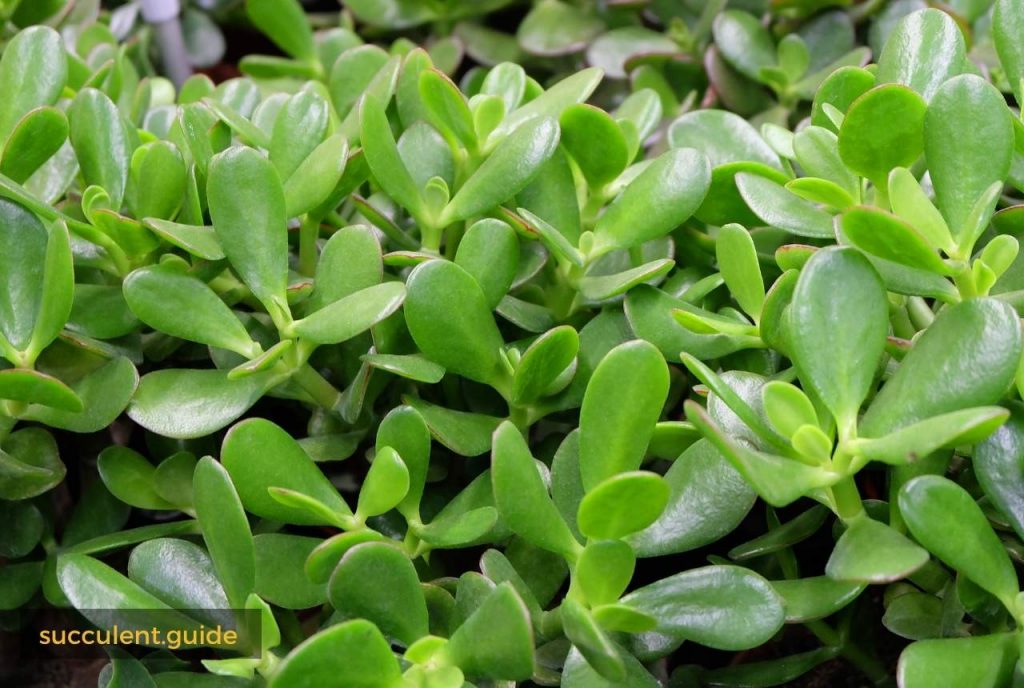Crassula ovata, commonly known as jade plant, money tree or lucky plant, is a succulent plant with small pink or white flowers that blooms in winter. It is native to Mozambique and South Africa and is widely cultivated as a houseplant.
Jade plants are easy to care for and make excellent houseplants. They are tolerant of neglect and can go for long periods without water. However, they will need more water during the active growing season (spring and summer). Allow the soil to dry out completely before watering again.
Quick Caring Highlight

Sun
Jade plants need bright light, but can tolerate some direct sun. They will do best in a south- or west-facing window.
Watering:
Water jade plants when the soil is dry to the touch. These plants are drought tolerant and can go for long periods without water, but they will need more water during the active growing season (spring and summer). Allow the soil to dry out completely between watering.
Fertilizing:
Fertilize jade plants once a month during the active growing season with a balanced fertilizer. Reduce watering and fertilizing in fall and winter when plant growth slows.
Propagation:
Jade plants can be easily propagated from stem cuttings. Take a 4-6 inch cutting from the tips of healthy stems and allow the cutting to callous over for a few days before potting it up in well-draining cactus or succulent potting mix.
Pests and Diseases:
Jade plants are generally resistant to pests and diseases, but they can be susceptible to mealybugs, scale, and spider mites. Watch for early signs of infestation and treat with an appropriate insecticide or pesticide.
Overwatering can lead to root rot, so be sure to plant jade plants in well-draining soil and allow the soil to dry out completely between watering.
Size:
Jade plants can grow to be quite large, up to 6 feet tall and wide. They are often used as specimen plants or accent plants in the landscape.
Varieties:
There are many different varieties of jade plant, including variegated varieties with cream- or pink-colored leaves.
Where to plant:
Jade plants do best in bright light, but can tolerate some direct sun. They will do best in a south- or west-facing window.
When to plant:
Plant jade plants in spring or summer.
How to plant:
To plant jade plants, choose a well-draining potting mix and a pot with drainage holes. Plant the jade plant in the center of the pot and water it well. Allow the soil to dry out completely between watering.
Full Care Guide:
Jade plants are easy to care for and make excellent houseplants. They are tolerant of neglect and can go for long periods without water. However, they will need more water during the active growing season (spring and summer). Allow the soil to dry out completely before watering again.
Bright light is best for jade plants, but they can tolerate some direct sun. Water jade plants when the soil is dry to the touch and fertilize monthly during the active growing season. Reduce watering and fertilizing in fall and winter when growth slows. These plants are susceptible to mealybugs, scale, spider mites, and root rot, so watch for early signs of infestation or disease and treat accordingly.
Jade plants can be easily propagated from stem cuttings. Take a 4-6 inch cutting from the tips of healthy stems and allow the cutting to callous over for a few days before potting it up in well-draining cactus or succulent potting mix.
With their easy care requirements and ability to thrive with neglect, jade plants make excellent houseplants. These hardy plants can reach 6 feet tall and wide, making them great accent or specimen plants in the landscape. There are many different varieties of jade plant available, including variegated varieties with cream- or pink-colored leaves.

1 thought on “Crassula Ovata”